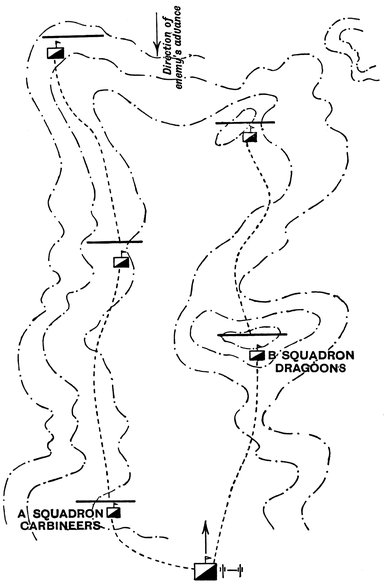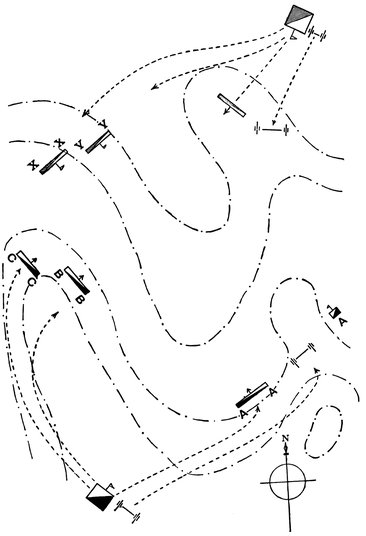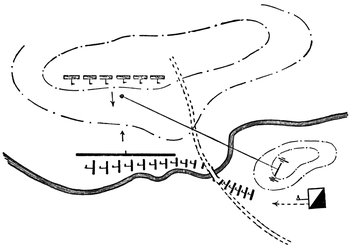1. To give the guns a good field of fire against the enemy’s attacking squadrons for as long as possible. This thought comes first, and the first order is accordingly that which puts the horse artillery in motion.
2. To keep our attacking squadrons from view of the enemy till the last moment.29
3. To make the line of direction of the cavalry attack such that it and the line of the artillery fire meet approximately at right angles on the mass of the enemy’s squadrons advancing to the attack, as already explained in the chapter on flank attack.
In order to attain a good field of fire for the guns it is often worth while to send two squadrons (not necessarily from the same regiment) to work towards the enemy en bondes, as the French expression is. For example (see Diagram V.), “A” squadron Carbineers pushes on half a mile or so (never more than a mile) and gets into any likely artillery position.

Diagram V.
“B” squadron Dragoons pushes on past their inner flank and gets into the next likely position61 half a mile farther on, and so on, each moving as soon as, or perhaps a little before, the other dismounts and gets ready to use rifle fire on all scouting parties, bodies of the enemy, etc. These parties are considerably disconcerted in their work by this mode of advance.
It is a point of honour, that these squadrons should if possible get up in time for the general encounter (unless detained as escort to horse artillery, a very likely contingency for one of them). But this bounden duty to be up in the fight, if possible, is a maxim with cavalry, against whom Inaction is the greatest reproach which can be levelled, next to cowardice, for which it is liable, and justly so, to be mistaken.
Having thus got a choice of artillery positions, and having determined the position of the enemy’s cavalry, our first care is to select the best position for the horse artillery.
(a) It must have a good field of fire over the ground where the encounter is likely to take place.
(b) We do not want the enemy to locate it; therefore it may be advantageous to unlimber under cover and then manhandle the guns up, or down into action; or it may remain behind cover and come into action when it is à propos. It is quite possible that in order to bring an effective fire on the enemy’s squadrons it may have to come into action on forward slopes.
(c) It is preferable for the guns to be defiladed from the enemy’s artillery.
62 (d) The teams should be near the guns but under cover.
(e) The escort should be under cover from view, mounted or ready to mount, prepared to charge attacking squadrons in flank. Rifle fire against squadrons, who have nerve enough to charge a battery of Q.F. guns, is not likely to stop them.30
Whether we take all our squadrons away to a flank, whether we use one regiment, or wing of a regiment, as a feint or bait, how far we go to a flank, in what formation, and the hundred other possibilities, we must leave to be settled at the time. Only the broad principles can then be focussed, viz.:—
1. Utilize the ground, choosing cover for the squadrons and good ground to work over.
2. Deceive and bewilder the enemy.
3. Get well away from our own artillery.
Example
i. The regiment or squadrons A——A sent with the horse artillery (see Diagram VI.) must not keep too near it, because the enemy’s horse artillery may get the range. Nothing shows more decidedly ignorance of the duties of escort to horse artillery than that the cavalry should hug or take into custody their horse artillery.

Diagram VI.
ii. It must not mask its own horse artillery fire against the enemy’s cavalry or upon his guns. The63 cavalry officer who masks his own guns by his clumsiness usually deserves to be shelled by them.
iii. The O.C. of the escorting regiment or squadrons must use his own judgment as to whether he can spare one, two, or three squadrons to help the two attacking regiments in the combat or in the rally.
iv. He must decide whether to be outside or inside the horse artillery, or in wings both outside and inside.
v. Often the O.C. the regiment or squadrons A——A may have to decide if he shall show up as bait, but in doing so he must, again, never mask the artillery. He may (in this case) move west to his left, especially if he thinks Blue cavalry is coming on and has not seen the regiments C——C and B——B making their flank movement. But usually the regiment or squadrons A——A should move up in this case more to the right, east, as this means that Blue horse artillery will come into action facing south and consequently cannot easily change front and pelt the regiments C——C and B——B.31
As our horse artillery will always if possible come into action on a hill or on high ground there will be some hill behind which A——A is able to man?uvre or to get cover, or to simulate (by showing up in different places) a larger force than it actually represents.
The leading of the regiments B——B and C——C64 will depend on the signals sent from the Brigadier (who rides wide on the inner flank—eastern side in this case—and where he can see the enemy’s advance) to the Brigade Major. These regiments B——B and65 C——C should make their move if possible under cover from view, and at the critical moment the order to attack should be conveyed to them.
As one of the objects of this man?uvre is to give our guns a good target, the O.C. horse artillery must direct his fire on the enemy’s squadrons, in this case, X——X and Y——Y. The enemy’s artillery, if already in action, will sustain little harm from his fire. The result of the encounter will depend on which side wins the shock action, therefore every shell which falls in an enemy’s squadron is a help. The enemy’s supporting squadrons are a special target, also the enemy’s rallying squadrons.
Let the O.C. horse artillery remember that the sight and sound of his bursting shells will often enlighten the Brigadier as to the position of the enemy’s squadrons and guide him in his attack, on which everything depends.
Before the combat, Resolution, i.e. fixedness of purpose, the instant adaptation of stratagem to the features of the terrain, an attack at the psychological moment galloping knee to knee; in the combat, constantly keeping a reserve and constantly re-forming into good order for the next effort,—these are the secrets with which to ensure coming successfully out of a cavalry encounter. “’Tis dogged as does it.” But do not let the leader imagine that he will always be making an advance, when this combat comes off.
Especially to be deprecated is the unreasoning gallop of squadrons, so commonly seen at man?uvres66 in an advance towards an enemy, which deprives them of any value from the reports of officers, patrols, etc.
If it is evident that the enemy has forestalled our man?uvre, and that any move to the front will place our brigade in the jaws of his attack, then, as Von Bernardi (page 147, Cavalry in War and Peace) says, the “deployment should either be on existing lines or to the rear, and should be covered by dismounted action of the advanced guard or by artillery fire. Only thus can the lost freedom of action be regained, as superior breadth of deployment is the first and perhaps the most important step towards maintenance of the initiative.”
Other cases in which it may be a positive advantage to allow the enemy some measure of initiative occur either when you are quite ignorant of his strength, or when the ground on which your squadrons stand or in their rear is most suitable for the combat from your point of view.
In the passage of defiles in the face of an enemy, say, in the case of a river or swamp, the rule is for the column, as it emerges from the far end of the defile, to move in column of troops parallel to the river or swamp. It will thus (i.) be ready to wheel into line and attack quickly, (ii.) there is no fear of the column being pushed back on to succeeding troops coming through the defile, (iii.) the head of the defile is kept clear of troops, (iv.) there is one safe flank for your column, i.e. that on the side of the swamp or river, and (v.) there is not the same67 danger of the enemy pounding32 an easy mark at the mouth of the defile with his artillery. If your own artillery can occupy any ground on this side of the defile, from which the exit can be seen, the accompanying diagram shows that a considerable force of your cavalry can make the passage with comparative safety under cover of its fire. It should always be remembered that the attack against troops, in course of the passage of a defile, will usually take place when only that proportion has crossed which the enemy thinks he can beat decisively.

Diagram VII.
A word of warning is necessary as regards a common and most enticing error, which is that of allowing squadron after squadron to be drawn into a fight.
68 As regards the dissemination of squadrons, this would not be such a serious matter if every detachment would return immediately its r?le had been played; but unfortunately Providence does not appear to make commanders of detachments like that; if it did, automatically our force would become, say, one-quarter stronger.
